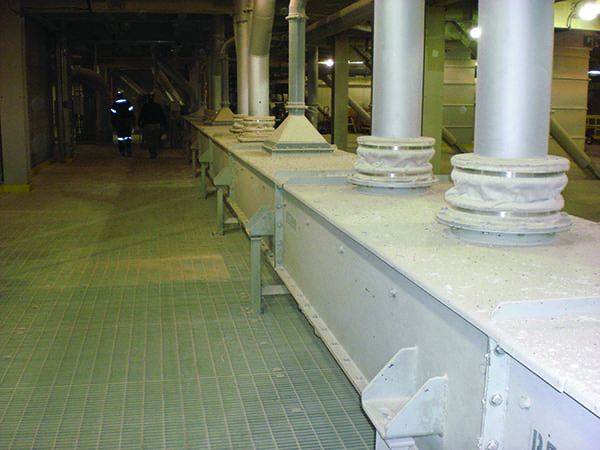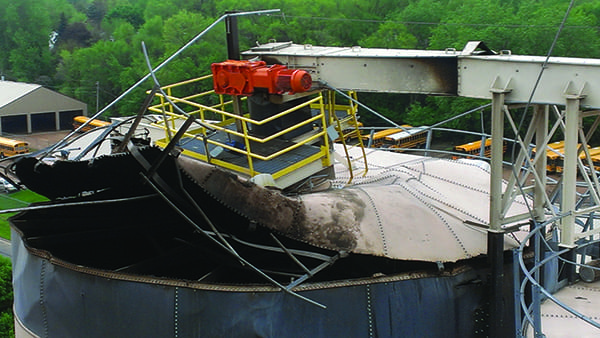Minimizing Fire and Explosion Hazards in Dusty Systems
From our Friends at: Powermag
Minimizing Fire and Explosion Hazards in Dusty Systems
Understanding the properties of bulk materials and how they interact with environmental factors is vital to safe operations, but having an honest conversation about the hazards, so risks can be properly addressed, could be the most important step toward reducing fire and explosion threats.
It should come as no surprise that fires and explosions cost companies billions of dollars each year. Lost productivity, the cost of repairing or replacing damaged or destroyed equipment, settling lawsuits originating from employee injuries or deaths—it all contributes to the total. Industrial operations are particularly familiar with the dangers of explosions (Figure 1), especially those that handle materials such as grain, sulfur, oil and gas, biomass, and wood pellets. Two recent incidents serve as sobering reminders of the significant financial and human costs associated with industrial explosions.
On May 31, 2017, an explosion destroyed a corn processing plant in Cambria, Wisconsin, killing five workers and injuring 12 others. Workplace safety inspectors later assessed a $1.8 million fine for what they called a preventable explosion that could have been avoided if the company had addressed hazards that are well-known in the grain industry—specifically, preventing heat or sparks that can ignite highly combustible grain dust. Officials from the U.S. Department of Labor’s Occupational Safety and Health Administration (OSHA) said it was the largest fine ever to emerge from a single workplace investigation in Wisconsin.
On October 11, 2017, three people were injured, one seriously, in an explosion at a fertilizer and farm equipment facility in Detroit, Maine. Fire officials said the incident occurred when a spark in a hopper ignited sulfur dust, which exploded. The plant’s general manager said the spark was caused by a foreman scraping a silo with a shovel, which hit an electrical wire on the silo and started a flash chemical fire. The results of an OSHA investigation were still pending at the time of this writing.
Open Communication Pays Dividends
These and countless other incidents that occur within industries that are susceptible to explosions can be mitigated or eliminated entirely in a variety of ways. Perhaps the most effective method of minimizing the risk of explosion involves a simple conversation or consultation at the beginning of the equipment selection process.
It’s true that any reputable equipment manufacturer will know that the potential for explosion exists within all of the aforementioned industries, as well as others. That knowledge will (or should) prompt them to ask certain questions in order to collect the required data for proper equipment selection. A conveyor manufacturer, for example, will ask if the equipment needs to be gas or vapor tight due to the nature of the product being handled. The customer’s answer will determine if the conveyor needs to be inert.
However, those responsible for the procurement of equipment in any industrial application must remember that it is their responsibility to inform their suppliers about the material they’re dealing with—and to do so in a way that makes it clear they need a plan for mitigating the potential for explosion. This stresses the importance of establishing a true partnership between customer and supplier, instead of treating the relationship as a simple business transaction. There needs to be a high level of trust and an open exchange of information in order to avoid catastrophic consequences.
Testing and Risk Mitigation Techniques
Often, the most important information regarding the explosive properties of a particular material—or, more accurately, the dust it creates—is revealed through third-party testing, which must be commissioned by the equipment purchaser. This testing will eliminate any guessing or doubt about potential dangers that could occur during the material-handling process.
Once this information has been obtained and shared with everyone involved in the design and implementation of the equipment, the supplier can pick up the proverbial ball and run with it. In the case of conveyors, manufacturers are able to plan for several safeguards that can help prevent explosions from happening or at least minimize the damage if they do occur.
Explosion Venting. Explosion venting is a relatively economical way to account for the potential for explosions. In fact, there are National Fire Protection Association (NFPA) standards in place that mandate the implementation of this safeguard when handling certain materials. In the event of a fire or explosion, vents will blow open when a certain force is reached to provide relief for the internal pressure caused by the incident. This provides a termination point that contains the damage to the conveyor. Without proper venting, equipment acts as a plenum or chimney and moves the volatility downstream, where a more catastrophic explosion could occur.
Nitrogen Purging. Nitrogen purging a conveyor will make it inert by limiting the amount of oxygen within the equipment so it doesn’t react with hydrocarbons and create explosive mixtures.
Adding Lifting/Grounding Lugs. Adding lifting/grounding lugs to conveyors can mitigate the potential for static electricity to create a spark or start an arc.
Using Plastic or Synthetic UHMW Paddles. Using plastic or synthetic ultra-high-molecular-weight (UHMW) polyethylene paddles to move material through the conveyor is another way to reduce the possibility of sparks by eliminating steel-to-steel contact within the equipment. As indicated by the two incidents referenced at the beginning of this article, sparks are among the most common causes of industrial explosions, and it only takes one to detonate volatile material dust.
Owners and Suppliers Must Work Together
Ultimately, none of these options can deliver the necessary benefit without open communication between customer and manufacturer. Experienced suppliers will understand that handling biomass or coal automatically goes hand in hand with potential explosion issues, and they will ask if it’s necessary to plan for certain safeguards when manufacturing the customer’s conveyors. Drag conveyors and bucket elevators, which are used in some fuel-handling applications, can be manufactured with a closed design to control dusting (Figure 2). But in most cases, that’s not enough to cover all the bases related to avoiding explosions.
 |
| 2. Designed for success. Understanding how material properties interact with conveyors is a crucial step toward fire prevention and explosion mitigation. Courtesy: CDM Systems Inc. |
With other materials, the explosion risk isn’t as obvious. That’s when full disclosure about material properties is absolutely essential (see sidebar). Equipment suppliers can only create a solution based on the information they receive from a customer. If that information is lacking for any reason, an explosion occurs, and an inspection by the NFPA reveals that the proper equipment wasn’t installed, insurance may not cover those losses. A single situation like that could be enough to shut an operation forever, not to mention the human cost of injury or loss of life.
| Property Loss Prevention Property insurance companies have a vested interest in reducing the risk of loss at power facilities. That’s why nearly all provide resources to help owners identify and mitigate hazards. For example, FM Global offers free access to proven engineering guidelines. These exacting standards can help companies reduce the chance of property loss due to fire, weather conditions, and failure of electrical or mechanical equipment. The guidelines incorporate FM Global’s nearly 200 years of property loss experience, research and engineering results, as well as input from consensus standards committees, equipment manufacturers, and others, to help owners reduce risks. One of FM Global’s Property Loss Prevention Data Sheets specifically applies to combustible dust. Data sheet 7-76 titled “Prevention and Mitigation of Combustible Dust Explosion and Fire” describes recommended preventive measures to reduce the frequency of combustible dust explosions and protection features to minimize damage from a combustible dust explosion. The 48-page document includes numerous equations and examples designed to help engineers solve complex and site-specific dust-control problems. A glossary of terms and detailed references are also included. —Aaron Larson is POWER’s executive editor. |
There are many challenges associated with conveying bulk materials. At the very top of the list is understanding the properties of those materials and how they interact with each other, as well as how they interact with all the environmental factors in a given operation. Equipment is one of those factors, and suppliers must adhere to a strict set of industry-standard guidelines for fire prevention and explosion mitigation when designing a proposed solution. But guidelines can’t account for everything a conveyor might encounter in a specific application. When customers provide results from third-party material testing, and suppliers offer their extensive knowledge about material characteristics and behavior acquired from years in the field, the likelihood of an explosion is minimized significantly—as is the potential for unimaginable losses. ■
—Andrew Parker is vice president for CDM Systems Inc. (www.cdmsys.com).

Comments
Post a Comment